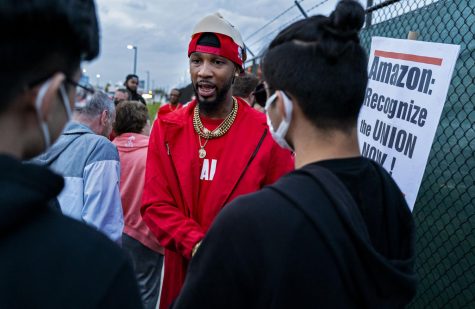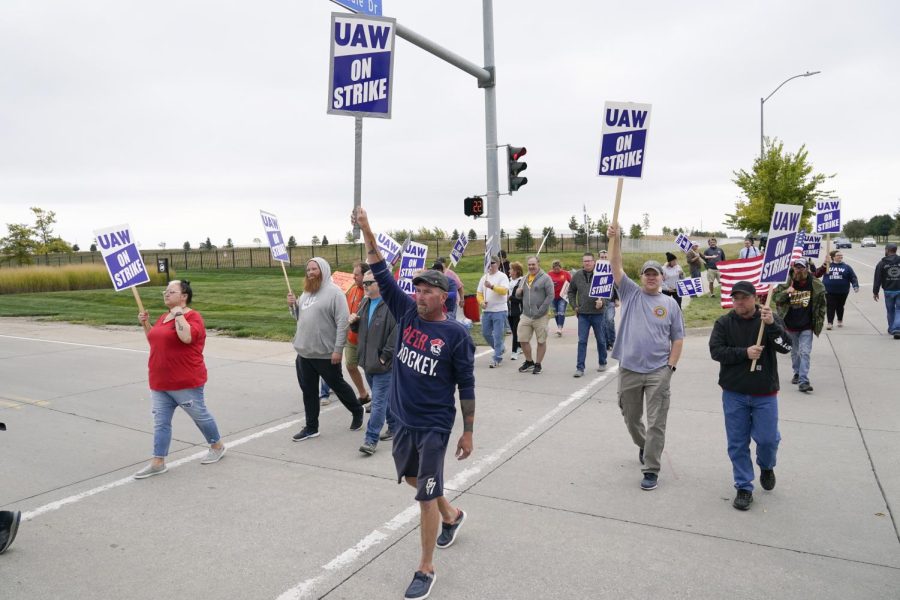Inside America’s labor revival
Members of the United Auto Workers strike outside of a John Deere plant, Wednesday, Oct. 20, 2021, in Ankeny, Iowa. About 10,000 UAW workers have gone on strike against John Deere since last Thursday at plants in Iowa, Illinois and Kansas.
Oct 28, 2021
One of the greatest tools the American workforce has had at their disposal is the labor union: organizations that negotiate with employers fair wages, benefits, hours and working conditions. Ever since the establishment of the first trade union in 1794, collective bargaining has been an integral part of the history of labor in this country. However, over the last century, this began to change as public opinion slowly swayed against organized labor. In 1947, the Taft-Hartley Act established right-to-work laws, or policies demanding that union benefits go to all workers, not just dues-payers, weakening the union’s overall negotiating power. This came in response to a series of labor strikes in the coal industry.
In addition, anti-union advocates utilized the Red Scare to discredit and destroy the labor unions, due to their ties to leftist ideology. Lastly, the association with organized crime later in the century, most notably in the case of Jimmy Hoffa and the Teamsters, further served to weaken the union’s reputation. The fall of the labor union is felt greatly today, as union membership is at an all-time low, while 28 states have adopted right-to-work laws (though Ohio is still a pro-union state). Ultimately, it seemed as if the once-powerful American labor movement had been condemned to die a cold and lonely death of irrelevance.
However, with worsening labor conditions and stagnant wages in our modern era, that might be changing sooner rather than later.
Over the last few years, pro-union sentiment has begun to sweep over the United States. As mentioned, a big part of this could be attributed to a failing economy that doesn’t seem to work for the average American. Wages have been stagnant, with the federal minimum wage having not increased since 2009. This is particularly a problem due to inflation, as $7.25 can’t buy you today what it could in 2009. Additionally, as a whole, working conditions in the United States have gotten worse.
Nowhere is this more prevalent than in the Amazon warehouses (called “fulfillment centers”). By now, many have heard the horror stories: long hours, disincentives towards breaks and constantly forced productivity. Most infamously, Amazon employees’ lack of bathroom breaks has led to stories of workers having to urinate in water bottles in order to avoid repercussions; while Amazon initially denied these claims, photo evidence proved otherwise. However, Amazon counters these claims by having a starting wage of $18 an hour, with benefits. That being said, it appears that poor working conditions outweigh goods wages in the eyes of the workers, as Amazon has an average worker turnover rate of 150% (keep in mind, this is before the COVID-19 pandemic). Lastly, Amazon workers dying during their shifts and workers being forced to continue nonetheless have become disturbingly common.
Speaking of, one could also argue that the COVID-19 pandemic also led to an uptick in pro-union sentiment. COVID was cited as putting many workers, especially health care workers and first responders, in an increased level of danger during the pandemic. Additionally, the goal of unions, being better wages, better work environments and stricter compliance with OSHA regulations made the idea of unionization a lot more enticing to the workforce over the course of the pandemic.
At the time of this writing, thousands of workers across the country, and across careers, are on strike in order to negotiate better conditions and fight either for the right to unionize, or rather to flex the power given to them by labor unions. A good example of this are the Kellogg’s workers currently on strike. From Michigan to Tennessee, cereal plant workers, members of the Bakery, Confectionery, Tobacco Workers and Grain Millers’ International Union are striking due to Kellogg allegedly backtracking on previous contract negotiations, including legacy pay and work hours. At the same time, employees at John Deere are making headlines with their own labor strike. This was caused by disputes over new labor contracts between John Deere and the United Auto Workers union, with the main points of contention being healthcare and retirement benefits. Though John Deere and the UAW have thus far negotiated a few proposals, the workers have voted them down, prolonging the strike.
Meanwhile, over 21,000 Kaiser Permanente workers began striking earlier this month after an overwhelming majority of its Union of Health Care Professionals voted to. Across the country, these workers are protesting changes to their wage system, as well as the after-effects of the COVID-19 pandemic. Lastly, also earlier this month, members of the International Alliance of Theatrical Stage Employees, one of Hollywood’s largest unions, voted to authorize a general strike. However, in a testament to the power of collective bargaining and organized labor, a strike was avoided, as the IATSE successfully negotiated a boost in hourly wages, new rules concerning breaks, and compensation from streaming. Though a strike was averted, several studios did end up having to delay projects.

While some workers are using their abilities as union members to improve their workplaces, some are fighting instead for the ability to even unionize to begin with. The most prominent example of this is Amazon, which has a long history of union-busting. Perhaps the best, most recent case of this was the union vote for their facility in Bessemer, Alabama. After the initial unionization vote failed by a nearly two-to-one margin, an investigation by the National Labor Relations Board found that Amazon had interfered with the vote by installing an unmarked mailbox as a ballot drop-off measure. As such, the NLRB has recommended a new election altogether, which would most likely occur next year.
However, the Bessemer facility is just a single example of Amazon’s affinity for union-busting. Amazon has long been efficient at anti-union propaganda (the Bessemer facility being a shining example). Additionally, Amazon took a cue from the past by allegedly hiring Pinkerton agents to spy on workers considering unionizing. For those who don’t know, the Pinkertons are a private detective agency with a long, prolific history of union-busting.
This ties into the unfortunate historical act of workers risking their lives for better pay and conditions. Notably, a John Deere striker was recently hit by a car and killed. Though this seems to have been an accident, many labor organizers have lost their lives in the process of unionization. Perhaps the most famous instance of this was the Haymarket Riots, in which a bomb went off during a labor strike in Chicago, causing a riot that resulted in the deaths of 11 people, as well as injuring several hundred.
Another bloodstain on America’s labor record was the 1921 Battle of Blair Mountain, at the time the largest armed uprising since the Civil War. West Virginia coal workers entered an armed standoff with law enforcement over the right to unionize the coal mines. Eventually, the U.S. Army had to get involved. This would lead to gunfights and even aerial assaults. Though it ultimately resulted in better mining conditions, union membership declined as a result and over 130 people lost their lives.
Though union-busting has a bloody history, the forms it has taken are not always violent: be it Amazon’s recent actions, the red-baiting and persecution of union members during McCarthyism, or the amounts of right-to-work legislation that sweep through the country after the 2010 midterms, union-busting has become almost as American as apple pie.
Labor unions have been beneficial to the American worker since their conception. They have kept you from getting paid pennies for your work. They have kept you from working long, long hours in horrible, unsafe conditions. It is often said that OSHA regulations are written in blood, and that is no exaggeration: it has been found that workplaces often become safer after unionization. Unions are ultimately beneficial for the labor force, and it is objectively good that many are beginning to take advantage of that.
It seems as if America is undergoing a new age of unionization, and it will be for the better. Content, safe and well-paid workers tend to be more productive than those who are forced to work double-digit shifts with little to no breaks. The fact that so many workers are either fighting for their labor rights or actually using their union power via striking is, for lack of a better word, pretty awesome.
It’s also far from over. As of the time of this writing, all of the strikes listed are still ongoing. The Bessemer Amazon facility will likely face another unionization vote within the next year, and another facility on Staten Island has filed for a union election. And though the focus has been mainly on blue-collar workers, white-collar workers (particularly journalists) have been just as eager to unionize. The icing on the cake is that, for the first time since the Progressive Era, the U.S. Secretary of Labor has been a part of the organized labor movement (Secretary Marty Walsh, former Mayor of Boston, was the president of a construction workers union). All in all, it seems that, after a century of defeat, the American labor movement could be in the midst of a revival. And I cannot wait to see where it goes.













